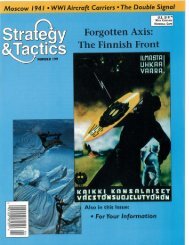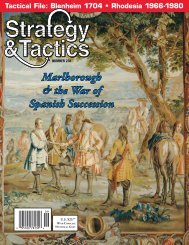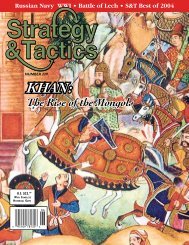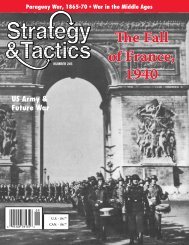COUNTERSTROKE AT SOLTSY - Strategy & Tactics Press
COUNTERSTROKE AT SOLTSY - Strategy & Tactics Press
COUNTERSTROKE AT SOLTSY - Strategy & Tactics Press
Create successful ePaper yourself
Turn your PDF publications into a flip-book with our unique Google optimized e-Paper software.
56 #232<br />
Kojiro’s razor sharp sword fell from his dead hand,<br />
it cut through the hem of Musashi’s skirt. Those two<br />
near misses made that fight the closest he ever came to<br />
being wounded or killed.<br />
In 1614, Musashi joined his old foes, the Tokugawas,<br />
as a mercenary and fought in the bloody siege of<br />
Osaka Castle. He continued to wander for another 20<br />
years plying his deadly trade until in 1634 he returned<br />
to Ogura and stayed with Lord Churi in Kumamoto. In<br />
1638, Musashi was present as an officer in the army<br />
that fought against the southern lords and the Japanese<br />
Christians who had risen in rebellion. The rebellion<br />
was ruthlessly crushed. Following that campaign, the<br />
Japanese closed their countries to foreigners for the<br />
next two centuries. Musashi once again chose his own<br />
course, and in 1643 at the age of 59 he sought solitude.<br />
He became a recluse living in a mountain cave called<br />
Reigendo.<br />
Go Rin No Sho –The Book of the Five Rings<br />
It was in Reigendo that Musashi dictated Go Rin<br />
No Sho, the Book of the Five Rings, to his student Teruo<br />
Nobuyuki as a series of letters. Go Rin No Sho is<br />
one of those cryptic books in which meaning is to be<br />
found in the interpretation of the reader. Beginners and<br />
Warrior elite: Samurai in full armor with bow.<br />
masters can read the same passage and find different<br />
meanings. Musashi himself stated he did not reach a<br />
full understanding of the Way until 1634, at the age of<br />
50, and that despite years of training and experience.<br />
Musashi wrote: “When you have attained the Way<br />
of strategy there will not be one thing that you cannot<br />
understand. You will see the Way in everything.”<br />
Musashi commanded no great armies and never<br />
sought power for himself. His dedication to his warrior<br />
skills and his almost mystical seeking of the Way<br />
has had influence on the psychology of the Japanese,<br />
not unlike the impact the Medieval European quest<br />
for the Holy Grail had on Western civilization (though<br />
Musashi is much better documented historically than,<br />
say, King Arthur). Indeed, the preface to every text<br />
on Kendo acknowledges a debt to Go Rin No Sho.<br />
Musashi had proved the Way was achievable. The enlightenment<br />
it brought was the essence of Musashi’s<br />
persona made him invincible in combat. To the Japanese<br />
he is ranked among the few who have been given<br />
the title of Kinsei, or Sword Saint, and even among<br />
that group Musashi stands alone.<br />
Musashi was not a brutal man, but his code meant<br />
he was merciless. He did not fear death in combat and<br />
expected no quarter from his opponents. By the same<br />
token, he gave no mercy if the circumstances demanded<br />
it. In his 30 years as a wandering ronin and mercenary,<br />
Musashi probably killed more than 100 men in<br />
combat, yet never suffered a single wound, no matter<br />
how many opponents faced him.<br />
In May 1645, shortly after dictating his last letter<br />
on the concept of void, Musashi died. He left behind<br />
no family and no Kendo school to carry on his work.<br />
Yet his reputation was such that he was not forgotten,<br />
and his book became the core text for those seeking to<br />
follow the Way. Musashi had sought only personal enlightenment,<br />
but his legacy for the Japanese is that he<br />
set such a high standard and laid out a code of behaviour<br />
many have sought to follow his example. None<br />
has equaled his achievements to this day.<br />
Bibliography<br />
The Book of the Five Rings – Miyamoto Musashi, Cassell Military Paperbacks,<br />
First Published 1994, Reprinted 2001 (Great Britain).<br />
A Book of Five Rings – Miyamoto Musashi, Translated by Victor Harris.<br />
The Outlook <strong>Press</strong>, Petere Mayer Publishers Inc, Woodstock, New<br />
York First Published 1974.<br />
The Book of Five Rings for Executives: Musashi’s Classic Book of Competitive<br />
<strong>Tactics</strong> – Donald G. Krause. W.S. Bookwell, Nicholas Brearley<br />
Publishing, 1998. (This is a well known popular book which<br />
mangles every idea Musashi championed to suit the business ideas<br />
of the author.)<br />
Musashi – Eiji Yoshikawa, translated by Charles Terry, ISBN 4-7700-<br />
1957-2<br />
Samurai Warfare – Dr. Stephen Turnbull. Arms and Armour <strong>Press</strong> (UK),<br />
(1998).







